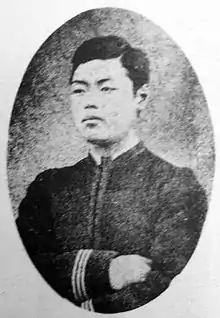Tsuda Sanzō
Tsuda Sanzo (津田 三蔵, 1855–1891) was a Japanese policeman who in 1891 attempted to assassinate Nicholas II of Russia, in what became known as the Ōtsu incident. He was convicted for attempted murder and sentenced to life imprisonment.

Bio
Born into a samurai family, his ancestors were doctors to the daimyōs of Iga.
In 1872 he was drafted into the army. He participated as a sergeant in the suppression of the uprising of the samurai in 1877 under the leadership of Saigō Takamori. His participation unsettled him, as Saigō Takamori was a symbol of Japanese spirit and dedication.
From 1882 onward, he served in the police force. During Nicholas II's state visit, he was assigned to guard the street that the distinguished guests would follow. Tsuda swung his saber at Nicholas, aiming at his head, but Nicholas turned and the blow grazed his head. Nicholas II was injured but survived. The attempt left a 9-centimeter scar on his head.
At the trial, Tsuda indicated that he had attempted to assassinate Nicholas because he suspected that he was a Russian spy. On May 25, 1891, Tsuda was sentenced to life imprisonment, which he had to serve in Hokkaido, often called "the Japanese Siberia". However, on September 30 of that year, Tsuda died in prison from pneumonia. According to another version, he starved himself to death.[1]
In his native village after the incident, it was forbidden to give newborn children the name Tsuda, and his family became outcasts. There were also calls to rename the city of Ōtsu because of its association with the disgraceful act.[2]
References
- Meshcheryakov, Aleksandr (31 October 2005). "Покушение на жизнь цесаревича Николая". Dojo (in Russian) (5). Japon.ru. Archived from the original on May 2, 2009.CS1 maint: unfit URL (link)
- Ufimtsev, Yuri. "Царя признали. Но не все" (in Russian). Konkurent.Ru. Archived from the original on 2012-10-16. Retrieved 2012-09-05.